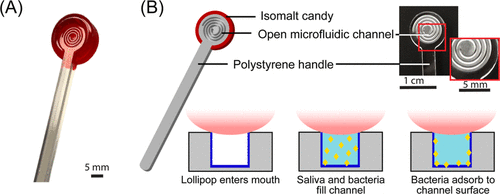These tasty lollipops ‘sweeten’ diagnostic testing for kids and adults alike
Researchers are now leveraging this ubiquitous symbol of pediatric consolation to transform the way diagnostic tests are performed.

[July 11, 2023: Staff Writer, The Brighter Side of News]
Researchers are now leveraging this ubiquitous symbol of pediatric consolation to transform the way diagnostic tests are performed. (CREDIT: Creative Commons)
When a child survives a doctor’s visit, a lollipop often serves as the spoils of victory. In a novel twist, researchers are now leveraging this ubiquitous symbol of pediatric consolation to transform the way diagnostic tests are performed, making them less invasive and significantly more enjoyable.
In a groundbreaking paper published in the American Chemical Society's 'Analytical Chemistry,' scientists introduced a lollipop-based saliva collection system designed to capture bacteria from adults. The study reports that this innovative, candy-themed device not only retains its efficacy for up to a year but also outperforms conventional sampling methods in terms of patient preference.
Standard diagnostic protocols frequently require throat swabs to collect samples for diagnosing a wide array of illnesses, including strep throat. However, the technique can be uncomfortable, often causing gagging. An alternative, less intrusive method is saliva sampling, where patient's spit is analyzed using advanced methods such as quantitative polymerase chain reaction (qPCR).
As these samples can be collected directly by patients, the method has seen a surge in popularity for at-home testing, a trend that markedly increased during the COVID-19 pandemic.
Related Stories
However, the task of producing sufficient saliva for testing can be somewhat unsavory, driving scientists to seek more palatable approaches. Enter the concept of the diagnostic lollipop, combining the drool-inducing, yet infinitely more pleasant, act of enjoying a sweet treat.
The team, led by Sanitta Thongpang, Ashleigh Theberge, and Erwin Berthier, had previously engineered a unique lollipop collection device, aptly named CandyCollect. Visually akin to a conventional lollipop, the CandyCollect stands out due to its spoon-like stick featuring a spiral-shaped groove on top. This flattened end is covered with isomalt candy, which prompts saliva production that then conveniently flows into the groove.
In a prior study, the team demonstrated that CandyCollect could effectively capture the bacteria responsible for strep throat under lab conditions. With these initial positive results, they were prompted to investigate whether their system could also capture other naturally occurring bacteria. They further sought to compare its performance with commercially available at-home saliva sampling methods in a real-world setting.
Respiratory infections are common in children, and there is a need for user-friendly collection methods. (CREDIT: Analytical Chemistry)
The researchers sent CandyCollect devices alongside two traditional saliva sampling kits to 28 adult volunteers. Participants used each method, responded to survey questions about their experiences, and then returned the devices to the lab for analysis. The team extracted the samples and quantified the presence of Streptococcus mutans and Staphylococcus aureus bacteria using qPCR.
The results were impressive: whenever conventional methods detected target bacteria, CandyCollect matched their detection rate 100% of the time. Notably, the CandyCollect method was the most popular among the participants, who also deemed it the "most sanitary" and "least disgusting." The lollipops proved their durability too, still yielding accurate results after a year's storage.
At-home saliva sampling devices for human subjects study. Self-saliva collection methods enable at-home sampling then shipping back to lab analysis. Three different collection methods included six CandyCollect devices, six ESwabTM, and two SpeciMAX Stabilized Saliva Collection Kits (from left to right). (A) wrapped (B) unwrapped. (CREDIT: Analytical Chemistry)
While ongoing studies aim to further validate these findings, the research team is optimistic about the adaptability and acceptance of the CandyCollect system. They hope that this work might inspire other scientists to develop more intuitive and convenient at-home testing methods.
Sweeter, more convenient diagnostics could revolutionize the field, particularly in an era that has seen a steep rise in at-home testing. If lollipops can transition from a simple post-doctor's visit treat to a critical tool in disease diagnosis, then who knows what other familiar, everyday items could be creatively co-opted to make medical procedures less daunting and more user-friendly. As they say, sometimes, the best medicine might indeed be a spoonful of sugar – or, in this case, a lollipop.
Note: Materials provided above by The Brighter Side of News. Content may be edited for style and length.
Like these kind of feel good stories? Get the Brighter Side of News' newsletter.



